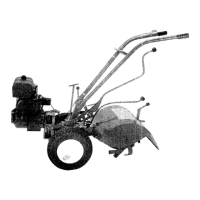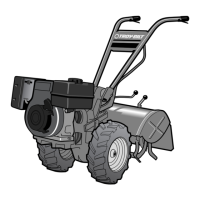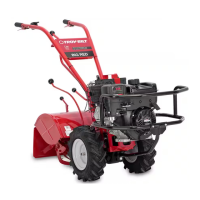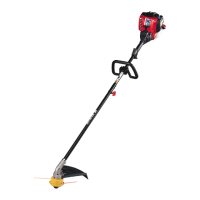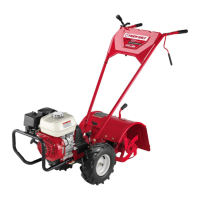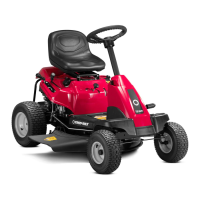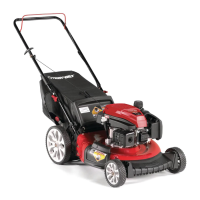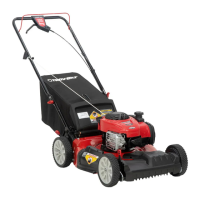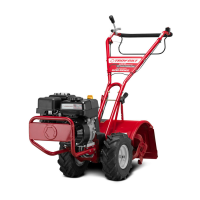(Photo 5/33) A heavy
mulch
of
hay
and
grass
clippings
can be easily
moved
to the
garden
in
a large
wheeled
cart
and
distributed
between
crop
rows
with
a fork.
When a layer
of
mulch
breaks
down
and the
level gets low,
it
should
be covered
up
once
again with more
mulch
material. You can
do
this once
or
twice
more
until
the
crop
is ready
for
harvest. Then,
you
can
till
the
crop
and
mulch
into
the soil
together
in
one
pass
with
the tiller.
You
don't
have
to
rake
or
shred
mulch
if
you
use
your
Troy-Bilt
Tiller
to
till
it
right
into
the
soil. If
you
have
grown
some
extra
tall cover
crops
such
as
rye grass
that
got
too
high
before
you
could
till
it
under
as
green manure, you can
cut
the rye grass
down
and spread it
as
mulch
elsewhere in the garden.
rye
barley
millet
other
common
crops
used:
cowpeas lespedeza
oats red
clover
soybeans
common-
vetch
MULCH
To keep
down
weeds between rows in the
garden, mulches are
generally
applied in the
mid-growing
season,
after
the soil has been
thoroughly
warmed up and has been well
cul-
tivated. See Photo 5/33.
At
that
time, a heavy
mulch
of
hay, old straw, grass
clippings
or
oth-
er dense
organic
materials is used
to
control
the weeds. Some people even use newspapers,
and others use rolls
of
plastic
"mulch."
News-
papers take
quite
a
while
to
break
down
and
decay and the plastic does
not
break
down
at
all, so it
contributes
nothing
to
the garden.
During
a cold, wet year, it's best
not
to
mulch
at all.
If
you are
going
to
plant later
crops
the next
year, such
as
corn, squash, melons,
or
beans,
you
can
plant
a perennial cover crop. You
might
want
to
till
under
a perennial
crop
of
winter
rye
or
wheat in May;
or
let
it
grow
until
late
May, then
cut
it
down
for
mulch
elsewhere and
till
under
the
remaining
stubble
for
its
nutri-
tional value
to
your
soil.
MOST
COMMON
KINDS OF COVER CROPS
There is a large variety
of
good
cover crops
such as:
grasses like
winter
rye, annual and
perennial:
grains
like buckwheat;
edible
veg~
etables
like
kale; and
legumes
(plants
that
have
the
ability
to
fix
nitrogen
from the air like alf-
alfa and soybeans). It
would
be best
to
consult
your
local
county
agent
as
to
which
crop
would
most
benefit
your
particular
soil. Here are some
nutrients
to
your
soil. Because
buckwheat
grows
so fast,
you
can plant one
crop
on
your
planned garden area in late May (in northern
climates) and
till
it
under
when the
buckwheat
is
about
12
to
14 inches high. While the
growth
is still a
luscious
green, this
height
is easiest
to
handle because it eliminates most tangling.
Also, it
will
be
readily digested by
earthworms
and soil life.
After
you have tilled in the first
crop
of
buck-
wheat, you can
sow
a second
crop
of
it
immedi-
ately.
Buckwheat
can germinate in
as
little
as
five days.
Sometime
in August, when the
second
crop
is again 12
to
14 inches tall, till
it
under. Then,
plant
either
annuals
or
peren-
nials
for
a
cover
crop
to
carry
through
the
winter,
depending
upon
your
need.
The
third
crop
you
plant will
protect
your
soil from erosion over the winter. Remember,
you
can
plant
cover crops
in
northern
climates
into
September.
Just
decide when and what
you are
going
to
place in the garden area the
next year.
If you are
going
to
plant the next year,
it is best
to
plan
an
annual cover
crop
to
carry
through
the
winter. A
cover
crop
such
as
annual rye grass,
which
will
grow
to
about
15
to
20 inches
high
by winter, will
protect
the soil,
hold
an even temperature in the
ground
and enable
earthworms
and
other
organisms
in the soil
to
work
throughout
the winter. The
annual rye grass
will
be
completely
devoured
by
soil life when the
snow
melts in the spring
and you can
plant
your
early garden.
70
I
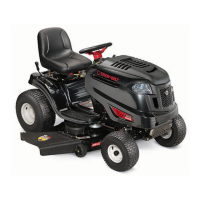
